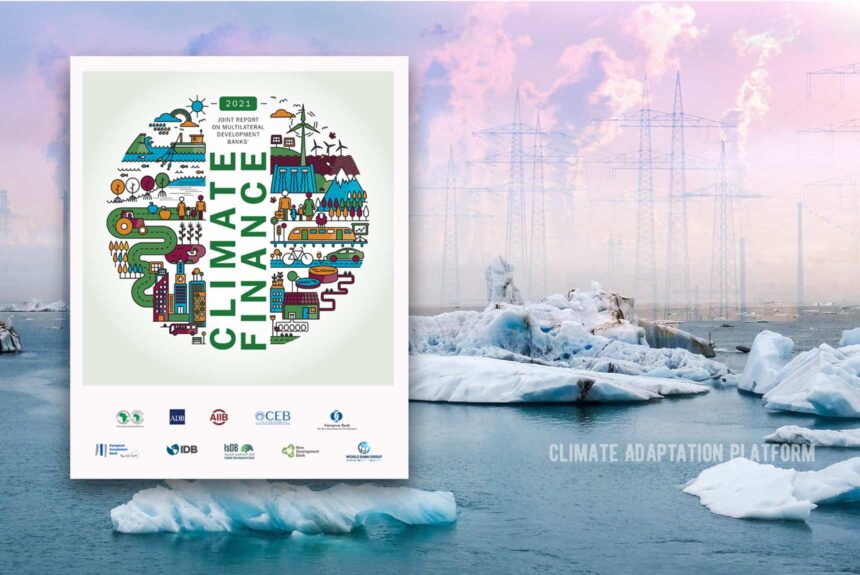The 2021 Joint Report on Multilateral Development Bank’s Climate Finance, published on October 2022, shows that in 2021 MBDs provided around $51 billion in climate finance to low- and middle-income countries.
The report was written by a group of multilateral development banks (MDBs), composed of the African Development Bank (AfDB), the Asian Development Bank (ADB), the Asian Infrastructure Investment Bank (AIIB), the Council of Europe Development Bank (CEB), the European Bank for Reconstruction and Development (EBRD), the European Investment Bank (EIB), the InterAmerican Development Bank Group (IDBG), the Islamic Development Bank (IsDB), the New Development Bank (NDB) and the World Bank Group (WBG).
According to the report, the 2021 figures surpass the 2025 climate finance goals set at the 2019 UN Secretary General’s Climate Action Summit in New York.
Of the $51 billion that MDBs provided to low- and middle-income countries, more than $33 billion went to climate change mitigation and more than $17 billion to climate change adaptation. The amount of mobilized private finance stood at $13 billion.
High-income countries also received $31 billion, of which $29 billion went to climate change mitigation and $1.6 billion to climate change adaptation. The amount of mobilized private finance stood at $28 billion.
The MDBs provided nearly $51 million in climate finance for low- and middle-income countries.
The report also records a notable increase in adaptation finance to over $19 billion in 2021, surpassing expectations. A total of $19.187 billion was committed to climate change adaptation finance, with $17.611 billion, or 92%, committed to low- and middle-income economies.
Kevin Kariuki, Vice President of Power, Energy, Climate and Green Growth at the African Development Bank, commented: “As MDBs, we have steadily grown the amount, and access to climate finance over the last decade, thereby demonstrating the potential of multilateralism in tackling global threats. However, this is not near enough, and efforts to ramp up the quantum of and rate of access to global climate finance, especially adaptation finance, in developing countries are necessary”. He added, “This is why we have established flagship programmes such as the $ 25 billion African Adaptation Acceleration Program and the $20 billion Desert-to-Power, to accelerate climate action while safeguarding the wellbeing of our people and nature” (Joint Report, 2022).
“These increasing levels of climate commitments from ADB and our partner institutions underscore the importance of climate change as the global issue of our lifetime,” said ADB Climate Envoy Warren Evans.
“In Asia and the Pacific, we are uniquely vulnerable. Whether it’s historic levels of flooding in Pakistan, devastating drought in the People’s Republic of China, or cyclones in the Pacific, our region knows full well the ever-present impact of climate change. It’s vital we continue to scale up this financing—for both mitigation and adaptation—to protect the lives and livelihoods of people in our region” (MDB’s Climate Finance, 2022).
Multilateral Banks’ role in climate finance
An article in the SDG by Dr Ayse Kaya, Professor, Swarthmore College; Adjunct Professor, The Wharton School, discusses the enormous potential of multilateral banks to deliver climate finance because of the capital they possess for disposal and their ability to raise additional funds through international markets. However, it is also plagued by a lack of transparency, detailed data and lagging financial commitment – this needs to be rectified.
Kaya recommends how multilateral banks can make climate financing more efficient – for funds to reach the most vulnerable countries that need it and to projects and initiatives that improve their lives and are not diverted or wasted through corruption.
She adds that money for climate adaptation needs to increase mainly in poor communities whose livelihoods depend on activities disproportionately impacted by climate change.
Currently, climate adaptation only accounts for one-third of all climate financing compared to two-thirds that goes to mitigation. The concessional share of funding is also meagre. It risks increasing the debt burden of developing countries and communities, which is the opposite of its purpose – boosting resilience and adaptation.
To read the entire report, CLICK the link below.
Source:
MDBs’ Climate Finance in Low and Middle-Income Countries Reaches $51 Billion in 2021. (2022 October 14). ADB. Retrieved from https://www.adb.org/news/mdbs-climate-finance-low-and-middle-income-countries-reaches-51-billion-2021
Joint Report on Multilateral Development Banks’ Climate Finance: Climate finance to low- and middle-income countries hits $51 billion in 2021. (2022 October 18). African Development Bank Group. Retrieved from https://www.afdb.org/en/news-and-events/press-releases/joint-report-multilateral-development-banks-climate-finance-climate-finance-low-and-middle-income-countries-hits-51-billion-2021-55539
Kaya, A. (2022 November 9). Multilateral Development Banks and Climate Finance: More Words Than Action. SDG Knowledge Hub. Retrieved from https://sdg.iisd.org/commentary/guest-articles/multilateral-development-banks-and-climate-finance-more-words-than-action



Leave a Reply